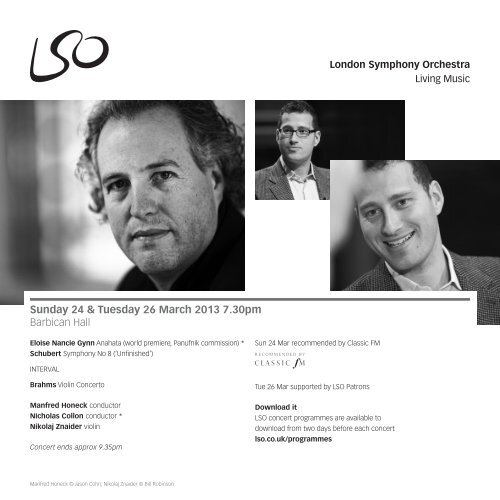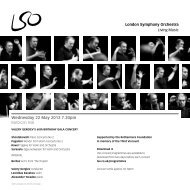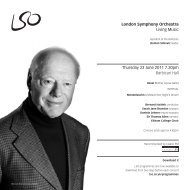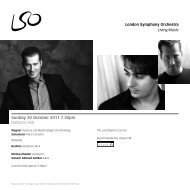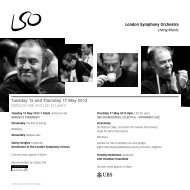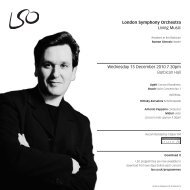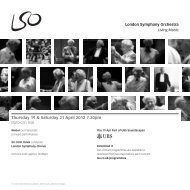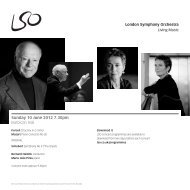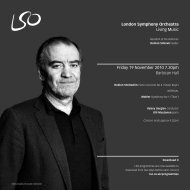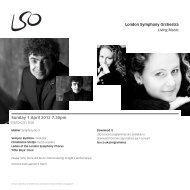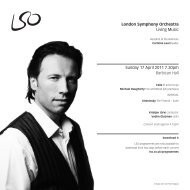Concert Programme - London Symphony Orchestra
Concert Programme - London Symphony Orchestra
Concert Programme - London Symphony Orchestra
Create successful ePaper yourself
Turn your PDF publications into a flip-book with our unique Google optimized e-Paper software.
<strong>London</strong> <strong>Symphony</strong> <strong>Orchestra</strong><br />
Living Music<br />
Sunday 24 & Tuesday 26 March 2013 7.30pm<br />
Barbican Hall<br />
Eloise Nancie Gynn Anahata (world premiere, Panufnik commission) *<br />
Schubert <strong>Symphony</strong> No 8 (‘Unfinished’)<br />
Sun 24 Mar recommended by Classic FM<br />
INTERVAL<br />
Brahms Violin <strong>Concert</strong>o<br />
Manfred Honeck conductor<br />
Nicholas Collon conductor *<br />
Nikolaj Znaider violin<br />
<strong>Concert</strong> ends approx 9.35pm<br />
Tue 26 Mar supported by LSO Patrons<br />
Download it<br />
LSO concert programmes are available to<br />
download from two days before each concert<br />
lso.co.uk/programmes<br />
Manfred Honeck © Jason Cohn; Nikolaj Znaider © Bill Robinson
Welcome<br />
News<br />
LSO St Luke’s celebrates its 10th Birthday<br />
This March marks ten years since LSO St Luke’s re-opened its doors<br />
following its dramatic renovation, enabling people of all ages to<br />
take part in music-making. Ten years have seen some of the world’s<br />
most renowned artists in ground-breaking activities, not to mention<br />
hundreds of BBC Radio 3 Lunchtime <strong>Concert</strong>s, UBS Soundscapes:<br />
Eclectica events and a plethora of community performances. Join us<br />
to celebrate from now until 1 April with a host of special events.<br />
Welcome to tonight’s LSO concert at the Barbican featuring<br />
Schubert’s <strong>Symphony</strong> No 8, Brahms’ Violin <strong>Concert</strong>o and Eloise<br />
Nancie Gynn’s Anahata, a new work composed as part of the<br />
LSO Panufnik Young Composers Scheme, supported by the<br />
Helen Hamlyn Trust.<br />
It is a pleasure to welcome back Manfred Honeck, who has stepped<br />
in to conduct tonight’s performance, for which we are most grateful.<br />
He is joined by violinist Nikolaj Znaider, a long-standing friend of the LSO.<br />
Sir Colin had been much looking forward to returning to the podium<br />
for these concerts with Nikolaj Znaider, but unfortunately he suffered<br />
a setback recently and has had to delay his return until the summer.<br />
I would like to extend sincere thanks to the LSO Patrons who are<br />
supporting the concert on 26 March; their generosity helps to ensure<br />
the continued success of the <strong>Orchestra</strong> and their enthusiasm for our<br />
music-making is an inspiration to every one of us. I would also like<br />
to thank our media partners Classic FM for their support of the<br />
24 March concert and their continued commitment to the LSO.<br />
I hope you enjoy tonight’s concert and can join us for Nikolaj Znaider’s<br />
next appearance with the <strong>Orchestra</strong> on 4 April at the Barbican.<br />
Kathryn McDowell<br />
LSO Managing Director<br />
lso.co.uk/lsostlukes10<br />
Follow the celebrations on twitter #lsostlukes10<br />
Mike gets moving for the LSO<br />
Mike Morfey, a long-standing Friend of the LSO, will be raising<br />
money for the <strong>Orchestra</strong>’s Moving Music campaign by running his<br />
55th marathon. Mike has been a supporter of the LSO for 50 years,<br />
and names the <strong>Orchestra</strong>’s ‘outstanding work away from the concert<br />
hall’, through education and community projects, as one of its most<br />
inspiring features. In running the Virgin <strong>London</strong> Marathon in April<br />
he supports LSO Discovery’s aim to bring musical experiences to<br />
a further 100,000 young people every year.<br />
justgiving.com/MikeMorfey2013<br />
Hiroaki Yamataka (1944–2013)<br />
The LSO was deeply saddened to learn that its International Vice-<br />
President, Mr Hiroaki Yamataka, passed away on Monday 14 January<br />
after a period illness. During his 30 years in <strong>London</strong>, Mr Yamataka<br />
became a great supporter of the LSO, joining its Board in 1990.<br />
He was instrumental in harnessing support from the Japanese<br />
business community in <strong>London</strong> and Tokyo, whose loyalty the LSO<br />
still benefits from today. We were delighted that his family was able<br />
to attend the <strong>Orchestra</strong>’s concert in Tokyo on 9 March, where there<br />
was the opportunity to remember the great work that Mr Yamataka<br />
undertook on behalf of the LSO.<br />
2 Welcome & News Kathryn McDowell © Camilla Panufnik
Eloise Nancie Gynn (b 1985)<br />
Anahata (world premiere, Panufnik commission)<br />
Anahata is inspired by my exploration of spirituality through meditation.<br />
Finding a way through life and its obstacles and emotions; a journey<br />
inside, from the head and all its mental chaos, thoughts and ‘stuff’ …<br />
into the stillness of the heart space, connecting to the peace within.<br />
The piece opens in an earthy, peaceful darkness; out of the low<br />
double bass note emerges a questioning bass clarinet, its melody<br />
gradually ascending, whilst occasionally dipping back to the depths.<br />
This undulating motif recurs throughout the piece echoed in different<br />
instruments, ending high in the flutes and two solo violins. The opening<br />
gestures feel as if they are breathing, changing colour as marimba<br />
and other instruments merge in and take over their original form.<br />
Anahata means ‘heart chakra’ in Sanskrit according to Hindu Yogic<br />
and Buddhist Tantric traditions. It is represented by the element of<br />
air, and this concept is reflected in the piece where the wind and<br />
brass blow air through their instruments. Out of this breath of life<br />
emerges an oboe solo, whose melody, using notes from an Indian<br />
raga mode, takes us on a journey, repeating through different voices<br />
and orchestrations. In the background, a gentle vibraphone and harp<br />
ostinato reminds us that life continues, repetitive, yet gradually<br />
ever-changing. Eventually the reality of life takes over, and the notes<br />
of the ostinato catapult us into an orchestral climax.<br />
It is said that the darkest hour comes just before dawn, and after<br />
this orchestral cascade we are plunged into a deep sound world,<br />
where bass drum and gongs echo the sound of a spiritual temple.<br />
Whilst the alto flute and viola reminisce the ostinato and opening<br />
motif, a cello quartet emerges singing a fragment of a Hindu mantra.<br />
Through going into our hearts we can find peace within, a sanctuary<br />
where we can observe life without getting caught up in its dramas.<br />
After a few moments of opening and ascension, the texture becomes<br />
light and clear: the celestial nature of Anahata reflected in high<br />
violins echoing the mantra and opening motif, surrounded by<br />
bowed vibraphone, celesta and Tibetan singing bowl.<br />
<strong>Programme</strong> Note © Eloise Nancie Gynn<br />
LSO DISCOVERY<br />
PANUFNIK YOUNG COMPOSERS SCHEME<br />
The LSO Panufnik Young Composers Scheme is an exciting<br />
initiative offering six emerging composers each year the<br />
opportunity to write for a world-class symphony orchestra.<br />
It has been devised by the LSO in association with Lady Panufnik<br />
in memory of her late husband, the composer Andrzej Panufnik,<br />
and is generously supported by the Helen Hamlyn Trust.<br />
Under the guidance of renowned composer Colin Matthews,<br />
the scheme enables composers to experiment over time and<br />
develop their orchestral writing skills; they form collaborative<br />
musical relationships with LSO players as well as witnessing<br />
their specially composed pieces put under the microscope<br />
by the LSO and François-Xavier Roth in a public workshop<br />
rehearsal – a major learning curve.<br />
Why not get a glimpse into a composer’s creative processes<br />
and watch the next Panufnik Young Composers Workshop on<br />
Thursday 11 April at LSO St Luke’s as part of LSO Futures?<br />
For more information, visit lso.co.uk/futures<br />
The LSO Panufnik Young Composers Scheme<br />
is supported by the Helen Hamlyn Trust<br />
<strong>Programme</strong> Notes<br />
3
Eloise Nancie Gynn (b 1985)<br />
In Profile<br />
‘I really like the spiritual nature of music’, she explains, ‘it is an<br />
intensely expressive language understood by all, even if the form and<br />
perception changes in different cultures. I love that in some cultures,<br />
music is seen as a connection between our earthly realm and the<br />
divine, and am influenced by music from all over the world.’<br />
Her new composition Anahata was commissioned as part of the<br />
LSO Panufnik Young Composers Scheme, which every year offers<br />
six emerging composers the opportunity to have their music<br />
workshopped by the LSO. ‘I love the creative freedom in having<br />
a whole orchestral palette of colours to choose from’, she says,<br />
‘and the support of having fantastic players, readily available to<br />
answer any queries!’.<br />
‘I really like the spiritual nature of music;<br />
that it is an intensely expressive language<br />
understood by all, even if the form and<br />
perception changes in different cultures.’<br />
Eloise Nancie Gynn draws her inspiration from nature, the world<br />
around her and from musical traditions from all over the globe.<br />
‘I have always been inspired by the nature of things’, she says,<br />
‘like the fractal patterns of a tree in winter, a river flowing deeply<br />
as it follows its pathway, or the different depth perception in a<br />
reflection in water. I grew up in Cornwall, where wild winds and<br />
the ever-changing moods of the sea shaped my childhood.’<br />
In a house full of instruments and with a father who reviewed<br />
recordings of world music, Eloise grew up taking an improvisational<br />
approach to music, teaching herself to play the guitar and the flute,<br />
and creating pieces for herself on the piano. She began her formal<br />
musical training at the age of twelve with the cello and later the<br />
Japanese shakuhachi, and her interest in music from different cultures<br />
continues in her work today; she sees music as a profoundly spiritual<br />
experience which can transcend language and cultural differences.<br />
Anahata draws on her experiences during a recent trip to India.<br />
Her impression of the spirituality of the people and their music,<br />
both classical and kirtan, led her to compose a work about life’s<br />
journey and finding inner peace. She hopes Anahata will allow the<br />
audience to ‘experience a sense of space within themselves’,<br />
and explains, ‘I love the feelings of peace and calm I experience<br />
when meditating or singing mantra. If I can ever convey these<br />
feelings through my compositions so that the audience can feel<br />
it too, then I will be very happy.’<br />
As for what’s next, the plan is simply to keep composing. ‘I would<br />
like to create more music in the future. I feel that by living my life<br />
connecting with the present, understanding myself, embracing my<br />
experience of life now, I can trust that what the future will bring will<br />
be fabulous. This is the message of Anahata, one of tuning into our<br />
hearts, in this moment.’<br />
Eloise was interviewed by Ciara Laverty<br />
4 Composer Profile
Franz Schubert (1797–1828)<br />
<strong>Symphony</strong> No 8 in B minor D759 (‘Unfinished’) (1822)<br />
1 Allegro moderato<br />
2 Andante con moto<br />
Music history is littered with incomplete compositions, from Bach’s<br />
Art of Fugue to Berg’s opera Lulu. So why, alone among them all,<br />
has the symphony that Schubert began in October 1822, and then<br />
abandoned with only two of its intended four movements completed,<br />
become known as the ‘Unfinished’? Why are Bruckner’s Ninth or<br />
Mahler’s Tenth, both regularly performed today in their partial state,<br />
not similarly entitled? The probable reason is that in most cases it was<br />
death that prevented fulfilment of the work, an implacable external<br />
force which gives no reason to cast doubt on a composer’s motivation<br />
or drive. Short though his life was, Schubert had another six years<br />
in which to finish the ‘Unfinished’, and he wrote many other works<br />
after it. Clearly the reason for its abandonment was an inner one.<br />
The known facts are inconclusive. When in August 1823 Schubert<br />
was elected an honorary member of a music society based in Graz,<br />
he offered to present them with the manuscript of the incomplete<br />
symphony as a token of thanks, perhaps with a promise to compose<br />
the rest of it soon. The score was duly given to the Society’s<br />
representatives, Joseph and Anselm Hüttenbrenner, in whose private<br />
hands it then remained. That they saw no reason to release it is not<br />
as perverse as it sounds; Schubert’s contemporary reputation was<br />
almost exclusively as a composer of vocal music, and, as far as we<br />
know, no symphony of his was accepted for public performance<br />
anywhere between the premiere of the Sixth in 1818 and his death<br />
ten years later. Thus it was only when latter-day Schubert-lovers<br />
wrested the score of the ‘Unfinished’ from Anselm over 40 years<br />
after it was written that it finally came to light, receiving its premiere<br />
in Vienna in 1865 to keen public interest.<br />
Whatever it was that stopped Schubert from completing the symphony<br />
we shall probably never know. A number of theories have been<br />
suggested, among the most convincing of which is that, having broken<br />
off composition with the third movement just begun, Schubert simply<br />
felt unable to pick up the threads of such an intensely personal work.<br />
His development as an instrumental composer was rapid at this time,<br />
and an ambitious desire to forge for himself a position as Beethoven’s<br />
acknowledged successor may well be the reason for a large number<br />
of other broken works from the years around 1820. Maybe, too, in his<br />
mind he had simply moved on by the time the chance to resume work<br />
on the ‘Unfinished’ presented itself; certainly its uniquely sustained brand<br />
of pained poetic lyricism was not one to which he later returned.<br />
The opening presents a bleak vision: a sinuous and menacingly<br />
subterranean theme intoned by cellos and double basses, followed by<br />
a nervous string accompaniment to an aching tune given out on oboe<br />
and clarinet. The music then builds steadily in volume until a held note<br />
on horns and bassoons swells into a brief but sturdy bridge to the<br />
lilting second theme. Announced by cellos and taken up by the violins,<br />
this new, major-key theme seems at first to promise a more carefree<br />
mood, but interruptions from the full orchestra suggest otherwise, and<br />
it is with a sense of relief that the theme later emerges in a sweetly<br />
extended version. After this first section has been repeated, a brief<br />
reminder of the opening then leads us into the dark realms of the<br />
central development section, which takes the cello-and-bass theme<br />
and works it up to a pitch of nightmarish intensity. The sequence of<br />
first and second themes is then reprised, before the introductory<br />
theme returns once again to initiate a world-weary, dejected coda.<br />
Schubert casts the slow second movement in E major, a distant key<br />
from the B minor of the first which enhances the sense of entering a<br />
different world. Indeed, the relationship between the two movements<br />
has been described by one writer as that of ‘a certain premonition of<br />
death and a vision of heaven’. But despite the Elysian beauty of the<br />
tender first theme, and even the apparent gruff cheerfulness with<br />
which its striding bass line at one point offers to take things over, the<br />
night-terrors still lurk. The clarinet’s nostalgic second theme is the first<br />
to hint at disquiet, but the orchestral outburst which rears its head<br />
later on leaves no doubt that true peace of mind is not to be had here.<br />
Schubert’s half-composed third movement is a bold and vigorous<br />
scherzo; what the finale might have been remains a mystery. But then,<br />
given the power of the music he had written already, perhaps that<br />
was too difficult a question even for Schubert to answer.<br />
<strong>Programme</strong> Note © Lindsay Kemp<br />
<strong>Programme</strong> Notes<br />
5
Franz Schubert (1797–1828)<br />
Composer Profile<br />
Johannes Brahms (1833–97)<br />
Composer Profile<br />
In childhood, Schubert was taught<br />
violin by his schoolmaster father<br />
and piano by his eldest brother.<br />
He rapidly became more proficient<br />
than his teachers and showed<br />
considerable musical talent,<br />
so much so that in 1808 he<br />
became a member of Vienna’s<br />
famous Imperial Court chapel choir.<br />
He was educated at the Imperial<br />
City College, where he received lessons from the composer Salieri.<br />
His father, eager that Franz should qualify as a teacher and work in<br />
the family’s schoolhouse, encouraged the boy to return home in 1814.<br />
Compositions soon began to flow, although teaching duties interrupted<br />
progress. Despite his daily classroom routine, Schubert managed<br />
to compose 145 songs in 1815, together with four stage works, two<br />
symphonies, two Masses and a large number of chamber pieces.<br />
Though the quantity of Schubert’s output is astonishing enough, it is<br />
the quality of his melodic invention and the richness of his harmonic<br />
conception that are the most remarkable features of his work.<br />
He was able to convey dramatic images and deal with powerful<br />
emotions within the space of a few bars, as he so often did in his<br />
songs and chamber works. The public failure of his stage works<br />
and the reactionary attitudes to his music of conservative Viennese<br />
critics did not restrict his creativity, nor his enjoyment of composition;<br />
illness, however, did affect his work and outlook. In 1824 Schubert<br />
was admitted to Vienna’s General Hospital for treatment for syphilis.<br />
Although his condition improved, he suffered side-effects from his<br />
medication, including severe depression. During the final four years<br />
of his life, Schubert’s health declined; meanwhile, he created some<br />
of his finest compositions, chief among which are the song-cycles<br />
Winterreise and Schwanengesang, and the last piano sonatas.<br />
Johannes Brahms was born in<br />
Hamburg, the son of an impecunious<br />
musician; his mother later opened<br />
a haberdashery business to help<br />
lift the family out of poverty.<br />
Showing early musical promise<br />
he became a pupil of the<br />
distinguished local pianist and<br />
composer Eduard Marxsen<br />
and supplemented his parents’<br />
meagre income by playing in the bars and brothels of Hamburg’s<br />
infamous red-light district. In 1853 Brahms presented himself to<br />
Robert Schumann in Düsseldorf, winning unqualified approval from<br />
the older composer. Brahms fell in love with Schumann’s wife, Clara,<br />
supporting her after her husband’s illness and death. The relationship<br />
did not develop as Brahms wished, and he returned to Hamburg;<br />
their close friendship, however, survived. In 1862 Brahms moved to<br />
Vienna where he found fame as a conductor, pianist and composer.<br />
The Leipzig premiere of his German Requiem in 1869 proved a<br />
triumph, with subsequent performances establishing Brahms as one<br />
of the emerging German nation’s foremost composers. Following the<br />
long-delayed completion of his First <strong>Symphony</strong> in 1876, he composed<br />
in quick succession the majestic Violin <strong>Concert</strong>o, the two piano<br />
Rhapsodies, Op 79, the First Violin Sonata and the Second <strong>Symphony</strong>.<br />
His subsequent association with the much-admired court orchestra in<br />
Meinigen allowed him freedom to experiment and de velop new ideas,<br />
the relationship crowned by the Fourth <strong>Symphony</strong> of 1884.<br />
In his final years, Brahms composed a series of profound works for<br />
the clarinettist Richard Mühlfeld, and explored matters of life and<br />
death in his Four Serious Songs. He died at his modest lodgings<br />
in Vienna in 1897, receiving a hero’s funeral at the city’s central<br />
cemetery three days later.<br />
Composer Profiles © Andrew Stewart<br />
6 Composer Profiles
Johannes Brahms (1833–97)<br />
Violin <strong>Concert</strong>o in D major Op 77 (1878)<br />
1 Allegro non troppo<br />
2 Adagio<br />
3 Allegro giocoso, ma non troppo vivace<br />
Nikolaj Znaider violin<br />
Brahms didn’t play the violin, but his understanding of it was second<br />
only to that of his own instrument, the piano. When he left his native<br />
Hamburg for the first time, it was to accompany the Hungarian<br />
violinist Eduard Reményi on a concert tour during which a famous<br />
episode demonstrated the twenty-year-old composer’s astonishing<br />
musicianship: one evening he discovered that the only available<br />
piano was tuned a semitone flat, and coolly transposed Beethoven’s<br />
C minor sonata up into C-sharp in order to play it at the right pitch.<br />
It was through Reményi that Brahms met the violinist Joseph Joachim,<br />
with whom he formed one of the closest friendships of his life,<br />
and whose playing was at the back of his mind whenever he<br />
composed for the violin. Joachim knew better than to pester the<br />
obstinate composer for a concerto, but must have known that it<br />
was only a matter of time before one eventually appeared.<br />
It came in the summer of 1878, soon after the Second <strong>Symphony</strong>, with<br />
which it shares something of its character. Not only is there a clearly<br />
symphonic cast to the music, but also the open lyricism that Brahms<br />
associated with the key of D major. Both works were composed at the<br />
same lakeside village in Carinthia; coincidentally, fifty years later Alban<br />
Berg would write his violin concerto on the shores of the same lake.<br />
Since Brahms tended to cover his tracks and say little about the<br />
gestation and composition of his music, we usually know very little<br />
about its background. It is quite possible that ideas for the concerto<br />
had been in his mind for some time; but during its composition there<br />
was a revealing correspondence with Joachim. We learn, for example,<br />
that the concerto was originally to have had four movements rather<br />
than the expected three (an idea Brahms reserved for his Second<br />
Piano <strong>Concert</strong>o, composed three years later). Joachim was himself a<br />
gifted composer, and in the past Brahms had often sought his advice<br />
on compositional matters. Now it was the solo violin part that Brahms<br />
sent to Joachim for his comments and technical help.<br />
Interestingly, he hardly ever actually took the advice his friend offered.<br />
He knew perfectly well what was effective and playable.<br />
The first performance of the new concerto was given in Leipzig on<br />
1 January 1879. Joachim played, of course, and Brahms conducted.<br />
It was entirely Joachim’s decision, though, to begin the concert with<br />
the Beethoven <strong>Concert</strong>o, of which he was the most famous player<br />
of the day. Brahms didn’t care for the idea. ‘A lot of D major’, he<br />
commented, but his unspoken objection was that he always disliked<br />
inviting comparisons with Beethoven, who was a very different type<br />
of composer. The only real similarities between the two concertos<br />
are that they are roughly equal in length and proportion, with a first<br />
movement longer than the other two together.<br />
Brahms misses no opportunity to show off the essential character<br />
of the violin. There is brilliance, power and lyricism in the solo<br />
part, which makes enormous demands on the player. For all its<br />
depth and subtlety of construction, though, the overall form of the<br />
concerto is almost obstinately traditional, ignoring the innovations<br />
of Mendelssohn in his famous concerto or even those found in<br />
the later Beethoven concertos. The first movement is a spacious<br />
design, with a long orchestral exposition. Although the themes are<br />
not in themselves extensive, they evolve from one another into long<br />
developments by soloist, orchestra, or both in partnership. This is<br />
the last of the great violin concertos in which the composer left it to<br />
the soloist to provide the expected cadenza. After so symphonicallyconceived<br />
a first movement, the other movements are more relaxed<br />
in mood and structure. The Adagio is coloured by the sound of the<br />
wind instruments, the soloist weaving delicate traceries around the<br />
main theme, but never playing it in its full form. The rondo finale pays<br />
tribute to Joachim’s own concerto ‘in the Hungarian style’, which he<br />
had dedicated to Brahms.<br />
<strong>Programme</strong> Note © Andrew Huth<br />
Andrew Huth is a musician, writer and translator who writes<br />
extensively on French, Russian and Eastern European music.<br />
<strong>Programme</strong> Notes<br />
7
Manfred Honeck<br />
Conductor<br />
‘Honeck is a graceful, darting<br />
presence on the podium …<br />
the detail, intelligence<br />
and energy he brings to<br />
his craft are striking’.<br />
The Washington Post<br />
Manfred Honeck was born in Austria and<br />
studied music at the Academy of Music in<br />
Vienna. An accomplished violinist and violist,<br />
he spent more than ten years as a member<br />
of the Vienna Philharmonic and the Vienna<br />
State Opera <strong>Orchestra</strong>. It is this experience<br />
that has heavily influenced his conducting<br />
and has helped give it a distinctive stamp.<br />
Honeck was appointed the ninth Music<br />
Director of the Pittsburgh <strong>Symphony</strong><br />
<strong>Orchestra</strong> in January 2007, and began his<br />
tenure at the start of the 2008/09 season.<br />
After a first extension in 2009, his contract<br />
was extended for the second time in<br />
February 2012, now through to 2019/20.<br />
Following their successful European Tour<br />
in 2010 and the European Festival Tour<br />
2011 with appearances at the major music<br />
festivals, such as the BBC Proms, Lucerne,<br />
Grafenegg, Rheingau, Schleswig-Holstein<br />
and Musikfest Berlin, he and the Pittsburgh<br />
<strong>Symphony</strong> <strong>Orchestra</strong> returned to Europe<br />
in October/November 2012. Honeck’s<br />
successful work in Pittsburgh is captured on<br />
CD by the Japanese label Exton. So far,<br />
Mahler Symphonies Nos 1, 3, 4 and 5,<br />
Tchaikovsky <strong>Symphony</strong> No 5 and Strauss’<br />
Ein Heldenleben have been released to<br />
critical acclaim. Their recording of Mahler<br />
<strong>Symphony</strong> No 4 has won an ICMA 2012 Award.<br />
From 2007–11, Honeck was Music Director<br />
of the Staatsoper Stuttgart where he<br />
conducted premieres including Berlioz’s<br />
Les Troyens, Mozart’s Idomeneo, Verdi’s Aida,<br />
Richard Strauss’ Rosenkavalier, Poulenc’s<br />
Dialogues des Carmélites and Wagner’s<br />
Lohengrin and Parsifal. His operatic guest<br />
appearances include Semperoper Dresden,<br />
Komische Oper Berlin, Théâtre de la Monnaie<br />
in Brussels, Royal Opera of Copenhagen,<br />
the White Nights Festival in St Petersburg<br />
and the Salzburg Festival.<br />
He commenced his career as conductor<br />
of Vienna’s Jeunesse <strong>Orchestra</strong>, which he<br />
co-founded, and as assistant to Claudio<br />
Abbado at the Gustav Mahler Youth<br />
<strong>Orchestra</strong> in Vienna. Subsequently, he<br />
was engaged by the Zurich Opera House,<br />
where he was bestowed the prestigious<br />
European Conductor’s Award in 1993.<br />
In 1996, Manfred Honeck began a three-year<br />
stint as one of three main conductors of<br />
the MDR <strong>Symphony</strong> <strong>Orchestra</strong> Leipzig and<br />
in 1997, he served as Music Director at the<br />
Norwegian National Opera in Oslo for a year.<br />
A highly successful tour of Europe with the<br />
Oslo Philharmonic marked the beginning<br />
of a close collaboration with this orchestra<br />
which consequently appointed him Principal<br />
Guest Conductor. From 2000–6 he was Music<br />
Director of the Swedish Radio <strong>Symphony</strong><br />
<strong>Orchestra</strong> Stockholm and served as Principal<br />
Guest Conductor of the Czech Philharmonic<br />
<strong>Orchestra</strong> from 2008–11, a position he will<br />
resume 2013–16.<br />
As a guest conductor Manfred Honeck<br />
has worked with major orchestras such as<br />
the Bavarian Radio <strong>Symphony</strong> <strong>Orchestra</strong>,<br />
Deutsches Symphonie-Orchester Berlin,<br />
Gewandhausorchester Leipzig, Staatskapelle<br />
Dresden, Royal <strong>Concert</strong>gebouw <strong>Orchestra</strong>,<br />
<strong>London</strong> Philharmonic <strong>Orchestra</strong>, Orchestre de<br />
Paris, Israel Philharmonic <strong>Orchestra</strong> and the<br />
Vienna Philharmonic; and in the US with the<br />
Chicago <strong>Symphony</strong> <strong>Orchestra</strong>, Los Angeles<br />
Philharmonic, National <strong>Symphony</strong> <strong>Orchestra</strong><br />
Washington and Boston <strong>Symphony</strong> <strong>Orchestra</strong>.<br />
He is also a regular guest at the Verbier<br />
Festival. Guest engagements of the 2012/13<br />
season include concerts in Stockholm and<br />
Prague as well as appearances with the<br />
New York Philharmonic and the Cleveland<br />
<strong>Orchestra</strong>, and his debut with the Berlin<br />
Philharmonic <strong>Orchestra</strong>.<br />
In 2010, Manfred Honeck earned an honorary<br />
doctorate from St Vincent College in Latrobe,<br />
Pennsylvania. He has also been Artistic<br />
Director of the International <strong>Concert</strong>s Wolfegg<br />
in Germany for more than 15 years.<br />
8 The Artists Manfred Honeck © Felix Broede
Nikolaj Znaider<br />
Violin<br />
‘What a meltingly gorgeous<br />
sound. In the cadenza,<br />
with the orchestral<br />
strings strumming like<br />
mandolins, 2,000 people<br />
hardly dared to breathe.’<br />
The Times on Nikolaj Znaider and the LSO<br />
Nikolaj Znaider is not only celebrated as one<br />
of the foremost violinists of today, but is fast<br />
becoming one of the most versatile artists of<br />
his generation uniting his talents as soloist,<br />
conductor and chamber musician.<br />
Nikolaj Znaider was invited by Valery Gergiev<br />
to become Principal Guest Conductor of the<br />
Mariinsky <strong>Orchestra</strong> in St Petersburg where<br />
he conducts opera productions, to include<br />
The Marriage of Figaro and Don Giovanni<br />
this season, and a number of symphonic<br />
concerts. He is a regular guest conductor with<br />
orchestras such as the Dresden Staatskapelle,<br />
Munich Philharmonic <strong>Orchestra</strong>, Czech<br />
Philharmonic, LA Philharmonic, Pittsburgh<br />
<strong>Symphony</strong> <strong>Orchestra</strong>, Orchestre Philharmonique<br />
de Radio France, Russian National <strong>Orchestra</strong>,<br />
Halle <strong>Orchestra</strong>, Swedish Radio <strong>Orchestra</strong> and<br />
Gothenburg <strong>Symphony</strong>. Last season he<br />
appeared as Artist-in-Residence with the<br />
Dresden Staatskapelle, and this season will make<br />
his conducting debut with the <strong>Concert</strong>gebouw<br />
Orkest and <strong>Orchestra</strong> of Santa Cecilia Rome.<br />
As a soloist, Znaider works regularly with the<br />
world’s leading orchestras and conductors<br />
such as Daniel Barenboim, Sir Colin Davis,<br />
Valery Gergiev, Lorin Maazel, Zubin Mehta,<br />
Christian Thielemann, Mariss Jansons,<br />
Charles Dutoit, Christoph von Dohnanyi,<br />
Ivan Fischer and Gustavo Dudamel. In recital<br />
and chamber music he appears at all the<br />
major concert halls.<br />
An exclusive RCA Red Seal recording artist,<br />
Znaider’s most recent addition to his<br />
discography is the Elgar Violin <strong>Concert</strong>o with<br />
Sir Colin Davis and the Dresden Staatskapelle.<br />
His award-winning recordings of the Brahms<br />
and Korngold Violin <strong>Concert</strong>os with the Vienna<br />
Philharmonic and Valery Gergiev, the Beethoven<br />
and Mendelssohn <strong>Concert</strong>os with Zubin Mehta<br />
and the Israel Philharmonic, and Prokofiev<br />
Violin <strong>Concert</strong>o No 2 and Glazunov <strong>Concert</strong>os<br />
with Mariss Jansons and the Bayerische<br />
Rundfunk have been greeted with great<br />
critical acclaim, as was his release of the<br />
complete works for violin and piano of Brahms<br />
with Yefim Bronfman. For EMI Classics he<br />
has recorded the Mozart Piano Trios with<br />
Daniel Barenboim and the Nielsen and Bruch<br />
<strong>Concert</strong>os with the <strong>London</strong> Philharmonic.<br />
Znaider is passionate about the education<br />
of musical talent and was for ten years<br />
Founder and Artistic Director of the Nordic<br />
Music Academy, an annual summer school<br />
whose vision it was to create conscious and<br />
focused musical development based on<br />
quality and commitment.<br />
Nikolaj Znaider plays the Kreisler Guarnerius<br />
del Gesu 1741, on extended loan to him<br />
by The Royal Danish Theater through the<br />
generosity of the Velux Foundations and<br />
the Knud Højgaard Foundation.<br />
NIKOLAJ ZNAIDER’s series<br />
continues with the LSO<br />
Thu 4 Apr 7.30pm<br />
Mozart Piano <strong>Concert</strong>o No 25, K503<br />
Mahler <strong>Symphony</strong> No 5<br />
Nikolaj Znaider conductor<br />
Piotr Anderszewski piano<br />
Sun 16 & Tue 18 Jun 7.30pm<br />
Mendelssohn Violin <strong>Concert</strong>o<br />
Schubert <strong>Symphony</strong> No 9 (‘The Great’)<br />
Sir Colin Davis conductor<br />
Nikolaj Znaider violin<br />
lso.co.uk/whatson<br />
Nikolaj Znaider © Bill Robinson<br />
The Artists<br />
9
Nicholas Collon<br />
Conductor<br />
Nicholas Collon is establishing<br />
an enviable reputation as a<br />
commanding and inspirational<br />
interpreter in an exceptionally<br />
wide range of music. As founder<br />
and Principal Conductor of Aurora<br />
<strong>Orchestra</strong> he has promoted<br />
imaginative programming that<br />
integrates challenging repertoire<br />
from the 20th and 21st centuries<br />
with masterworks of the Classical and Romantic eras. Nicholas and<br />
Aurora were winners of Best Ensemble at the 2011 RPS Awards.<br />
In addition to his work with Aurora, he is increasingly in demand<br />
as a guest conductor with other ensembles in the UK and abroad.<br />
He is the recipient of the 2012 Critics’ Circle Award for Exceptional<br />
Young Talent and was Assistant Conductor to Vladimir Jurowski at<br />
the <strong>London</strong> Philharmonic <strong>Orchestra</strong> for the 2011/12 season.<br />
Having made a very successful debut at the BBC Proms in 2010,<br />
Nicholas was re-invited to both 2011 and 2012 with Aurora <strong>Orchestra</strong><br />
and with the <strong>London</strong> Sinfonietta and Birmingham Contemporary<br />
Music Group. Last season, Nicholas made his debuts with the <strong>London</strong><br />
Philharmonic <strong>Orchestra</strong>, the Philharmonia <strong>Orchestra</strong>, <strong>London</strong> Mozart<br />
Players, Northern Sinfonia and the Munich Chamber <strong>Orchestra</strong> at<br />
the Munich Biennale. He also he made his concert debut with the<br />
BBC Scottish in a programme of Philip Glass and Strauss. In 2012/13<br />
he will make further debuts with the City of Birmingham <strong>Symphony</strong><br />
<strong>Orchestra</strong>, the BBC Philharmonic, Spanish National <strong>Orchestra</strong>,<br />
Orchestre National d’Ile de France, Bournemouth <strong>Symphony</strong>,<br />
BBC National <strong>Orchestra</strong> of Wales, Academy of Ancient Music,<br />
Auckland Philharmonia and Ensemble Intercontemporain.<br />
Nicholas will make his debuts with English National Opera in The Magic<br />
Flute, Welsh National Opera in Jonathan Harvey’s Wagner Dream<br />
during the 12/13 season and also make his debut with Glyndebourne<br />
on Tour in autumn 2013. With the Opera Group he has conducted<br />
the first performances of Elena Langer’s The Lion’s Face and Luke<br />
Bedford’s Seven Angels.<br />
BBC RADIO 3 LUNCHTIME CONCERTS<br />
10TH BIRTHDAY FESTIVAL<br />
Tue 26 Mar 1pm<br />
Wihan Quartet<br />
Mozart String Quartet in D minor<br />
Dvořák String Quartet in F major (‘American’)<br />
Wed 27 Mar 1pm<br />
LSO String <strong>Orchestra</strong><br />
Schoenberg Verklärte Nacht<br />
Tchaikovsky Serenade for Strings<br />
Thu 28 Mar 1pm<br />
Nicholas Angelich<br />
Ravel Oiseaux tristes from ‘Miroirs’<br />
Ravel Valses nobles et sentimentales<br />
Mussorgsky Pictures at an exhibition<br />
Fri 29 Mar 1pm<br />
Nash Ensemble<br />
Schubert Octet<br />
Tickets £10 (£9 concessions)<br />
020 7638 8891 | lso.co.uk/lunchtimeconcerts<br />
<strong>London</strong> <strong>Symphony</strong> <strong>Orchestra</strong><br />
10 The Artists Nicholas Collon © Benjamin Ealovega
On stage<br />
First Violins<br />
Gordan Nikolitch Leader<br />
Tomo Keller<br />
Lennox Mackenzie<br />
Martyn Jackson<br />
Nigel Broadbent<br />
Ginette Decuyper<br />
Jörg Hammann<br />
Maxine Kwok-Adams<br />
Claire Parfitt<br />
Harriet Rayfield<br />
Colin Renwick<br />
Ian Rhodes<br />
Sylvain Vasseur<br />
David Worswick<br />
Jan Regulski<br />
Gerald Gregory<br />
Second Violins<br />
David Alberman<br />
Thomas Norris<br />
Sarah Quinn<br />
Miya Vaisanen<br />
David Ballesteros<br />
Richard Blayden<br />
Matthew Gardner<br />
Belinda McFarlane<br />
Andrew Pollock<br />
Paul Robson<br />
Louise Shackelton<br />
Elizabeth Pigram<br />
Eleanor Fagg<br />
Ingrid Button<br />
Violas<br />
Paul Silverthorne<br />
Gillianne Haddow<br />
Malcolm Johnston<br />
Julia O’Riodan<br />
Regina Beukes<br />
German Clavijo<br />
Lander Echevarria<br />
Anna Green<br />
Richard Holttum<br />
Robert Turner<br />
Jonathan Welch<br />
Josh Greenlaw<br />
Cellos<br />
Timothy Hugh<br />
Alastair Blayden<br />
Jennifer Brown<br />
Mary Bergin<br />
Noel Bradshaw<br />
Eve-Marie Caravassilis<br />
Daniel Gardner<br />
Hilary Jones<br />
Minat Lyons<br />
Amanda Truelove<br />
Double Basses<br />
Colin Paris<br />
Nicholas Worters<br />
Patrick Laurence<br />
Matthew Gibson<br />
Thomas Goodman<br />
Jani Pensola<br />
Joao Seara<br />
Simo Vaisanen<br />
Flutes<br />
Gareth Davies<br />
Siobhan Grealy<br />
Piccolo<br />
Sharon Williams<br />
Oboes<br />
Fabien Thouand<br />
Michael O’Donnell<br />
Cor Anglais<br />
Christine Pendrill<br />
Clarinets<br />
Christopher Richards<br />
Chi-Yu Mo<br />
Bass Clarinet<br />
Lorenzo Iosco<br />
Bassoons<br />
Rachel Gough<br />
Joost Bosdijk<br />
Contra Bassoon<br />
Dominic Morgan<br />
Horns<br />
John Thurgood<br />
Angela Barnes<br />
Estefanía Beceiro Vazquez<br />
Jonathan Lipton<br />
Trumpets<br />
Roderick Franks<br />
Gerald Ruddock<br />
Robin Totterdell<br />
Trombones<br />
Dudley Bright<br />
James Maynard<br />
Bass Trombone<br />
Paul Milner<br />
Tuba<br />
Patrick Harrild<br />
Timpani<br />
Nigel Thomas<br />
Percussion<br />
Neil Percy<br />
David Jackson<br />
Harp<br />
Karen Vaughan<br />
Piano<br />
John Alley<br />
LSO String<br />
Experience Scheme<br />
Established in 1992, the<br />
LSO String Experience<br />
Scheme enables young string<br />
players at the start of their<br />
professional careers to gain<br />
work experience by playing in<br />
rehearsals and concerts with<br />
the LSO. The scheme auditions<br />
students from the <strong>London</strong><br />
music conservatoires, and 20<br />
students per year are selected<br />
to participate. The musicians<br />
are treated as professional<br />
’extra’ players (additional to<br />
LSO members) and receive<br />
fees for their work in line with<br />
LSO section players.<br />
Kate Suthers (first violin),<br />
Julia Pusker (second violin),<br />
Kristina Chalmovska (cello) and<br />
Doo Woong Chung (double<br />
bass) performed in these<br />
two concerts, while Louisa<br />
Tatlow (viola) participated in<br />
rehearsals.<br />
The Scheme is supported by:<br />
Fidelio Charitable Trust<br />
The Lefever Award<br />
Musicians Benevolent Fund<br />
List correct at time of<br />
going to press<br />
See page x for <strong>London</strong><br />
<strong>Symphony</strong> <strong>Orchestra</strong> members<br />
Editor<br />
Edward Appleyard<br />
edward.appleyard@lso.co.uk<br />
Photography<br />
Igor Emmerich, Kevin Leighton,<br />
Bill Robinson, Alberto Venzago<br />
Print<br />
Cantate 020 7622 3401<br />
Advertising<br />
Cabbell Ltd 020 3603 7937<br />
The <strong>Orchestra</strong><br />
11
Take Your Seat<br />
An exceptional opportunity to put your name<br />
on the City’s newest performance venue<br />
Be a part of the Guildhall School’s exciting new building at Milton Court, opening in 2013,<br />
and take a leading role by naming a seat in the <strong>Concert</strong> Hall or Theatre.<br />
Your donation will help provide the very best facilities for future generations of young artists.<br />
Seats are available from £500 with engraved plaque.<br />
Further information:<br />
www.gsmd.ac.uk/takeyourseat or contact us: 020 7382 7179 or development@gsmd.ac.uk


